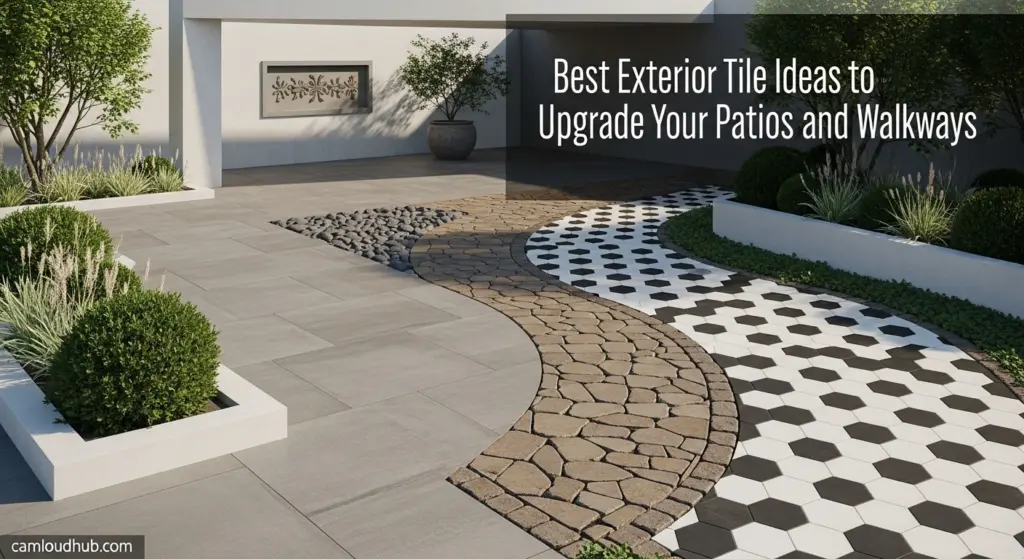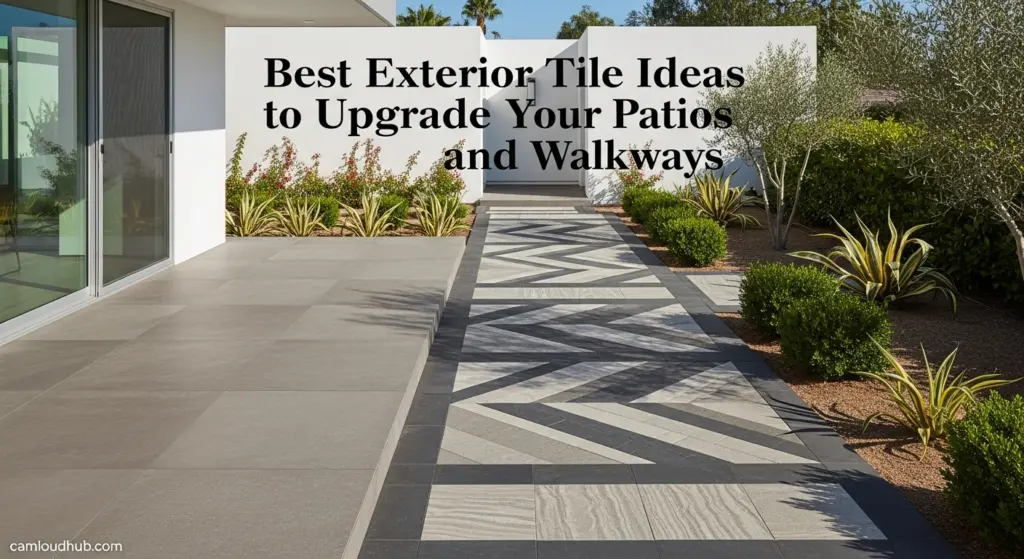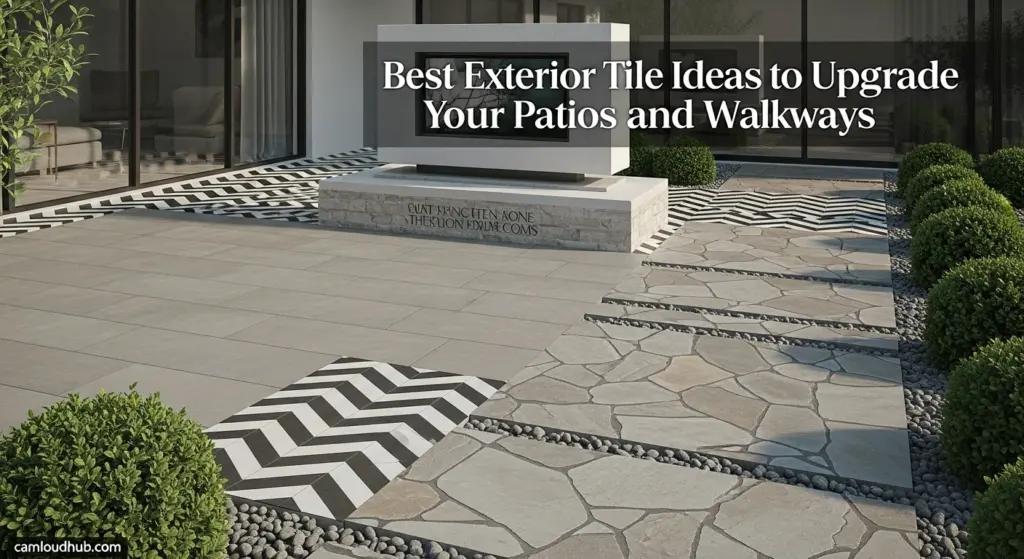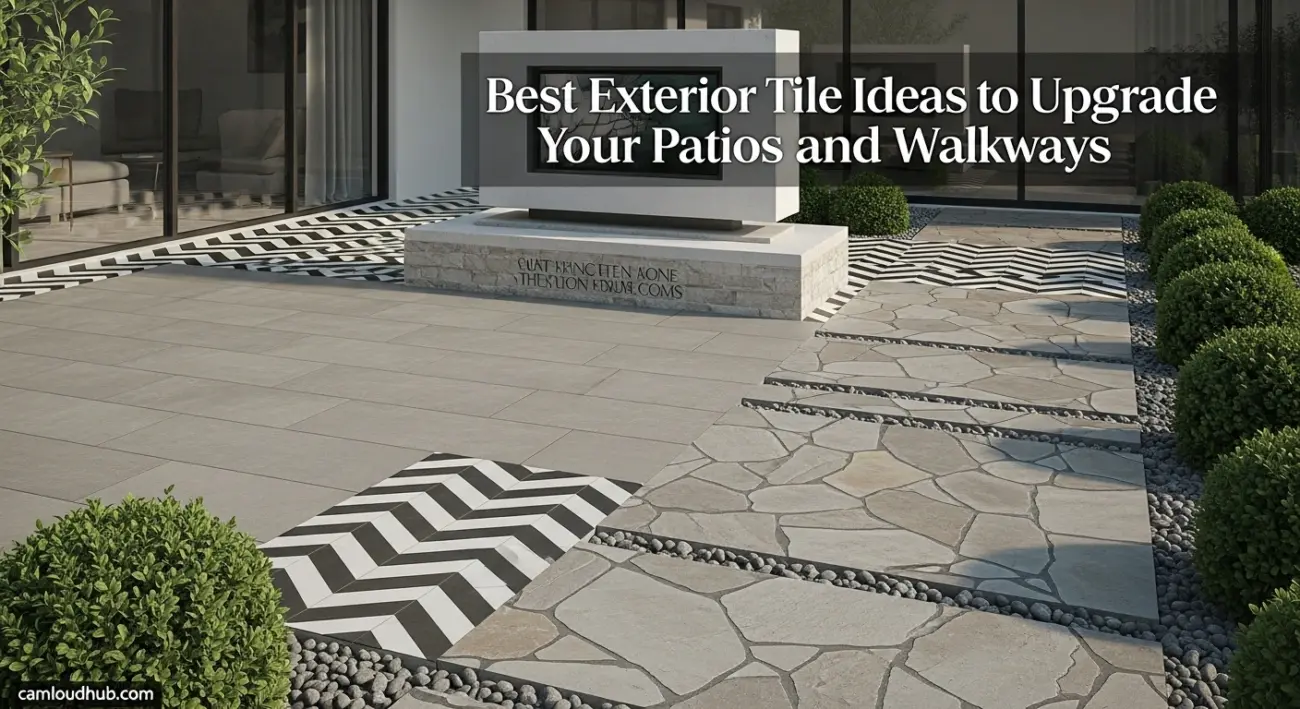Understanding the Fundamentals of Exterior Tile Selection
Best Exterior Tile Ideas to Upgrade Your Patios and Walkways – Choosing the right tile for outdoor use goes beyond mere aesthetics. Understanding the specific needs of your space, factoring in environmental conditions, and considering safety are all crucial elements that influence the longevity and performance of your tiled area. Making informed decisions from the outset can save you considerable time, money, and potential headaches down the line.
Identifying Your Needs and Defining the Purpose of the Space
Before diving into specific tile types and designs, consider the primary function of your outdoor area. Will it be a high-traffic walkway, a relaxing patio for lounging, or a poolside oasis? The intended use will significantly influence the type of tile you select. For instance, a patio designed for frequent entertaining requires a durable and stain-resistant material, while a pool deck demands slip-resistant tiles for safety.

Thinking about how you’ll use the space – from barbecues to yoga sessions – will help narrow down your options and ensure a practical and beautiful result. Consider factors like the amount of foot traffic, potential for spills, and exposure to the elements. Documenting these aspects upfront will streamline the selection process and help you choose tiles that perfectly match your lifestyle and outdoor area’s intended purpose. This might include things like noting typical guest numbers, assessing the sun exposure throughout the day, or thinking about potential furniture arrangements.
Key Considerations: Climate, Weather, and Durability Required
Outdoor tiles are constantly exposed to the elements. It’s critical to select materials that can withstand your local climate. Consider factors like freezing temperatures, heavy rainfall, intense sunlight, and fluctuating humidity levels. If you live in an area with harsh winters, look for tiles with a high frost resistance to prevent cracking and damage. For sunny climates, opt for tiles with UV resistance to prevent fading and discoloration over time. Furthermore, evaluate the durability requirements based on the level of foot traffic.
High-traffic areas will need tiles with a high abrasion resistance (PEI rating) to prevent wear and tear. Choosing durable and weather-resistant tiles is an investment in the longevity and beauty of your outdoor space, ensuring years of enjoyment without the constant need for repairs and replacements. The Porcelain Enamel Institute Rating (PEI) indicates a tile’s resistance to abrasion. Tiles with a rating of 3 or higher are typically suitable for outdoor use. Look for tiles specifically labeled as “frost resistant” or “suitable for outdoor use.”
Prioritizing Safety: Slip Resistance Ratings and Texture
Safety should be a top priority, especially in areas prone to wetness, such as pool decks and walkways. Look for tiles with a good slip-resistance rating, often indicated by a coefficient of friction (COF) value. A higher COF indicates better slip resistance. Tiles with textured surfaces, such as those resembling natural stone or featuring raised patterns, also provide enhanced grip.
Remember that tiles can become slippery when wet, so it’s essential to choose a material that minimizes the risk of falls. Incorporate features like textured inlays or strategically placed non-slip mats to further enhance safety in high-risk areas. Understanding the specific slip resistance requirements for different applications will help you make informed decisions and create a safe and enjoyable outdoor environment for you and your guests. Regulations and building codes may also specify minimum slip resistance requirements for certain outdoor areas, so be sure to check with local authorities.
Exploring Popular Exterior Tile Materials
The choice of material is foundational to the look, feel, and performance of your outdoor space. From the classic appeal of porcelain to the rustic charm of natural stone, each material brings unique characteristics and offers varying levels of durability, maintenance requirements, and aesthetic appeal.
Porcelain Tiles: Versatility, Durability, and Low Maintenance
Porcelain tiles are a popular choice for outdoor applications due to their exceptional versatility, durability, and low maintenance requirements. They are highly resistant to water absorption, making them suitable for climates with frequent rainfall or freezing temperatures. Porcelain tiles are also incredibly strong and can withstand heavy foot traffic without cracking or chipping. This makes them an excellent choice for patios, walkways, and driveways. They are available in a vast array of colors, sizes, styles, and textures, realistically mimicking natural stone, wood, and other materials. Their low-maintenance nature is another significant advantage.
They are easy to clean and resistant to stains, mold, and mildew, requiring minimal upkeep to keep them looking their best. Look for porcelain tiles specifically designed for outdoor use, as they have undergone rigorous testing to ensure they can withstand the elements. The manufacturing process involves firing at extremely high temperatures, resulting in a dense and durable material that is ideal for outdoor conditions.
Natural Stone Tiles: Timeless Beauty and Natural Variation
Natural stone tiles, such as slate, travertine, granite, and limestone, offer timeless beauty and unparalleled natural variation. Each stone has its unique patterns, colors, and textures, adding character and sophistication to any outdoor space. Stone tiles provide a natural, earthy aesthetic that blends seamlessly with the surrounding environment. They are also incredibly durable and can withstand heavy use for decades. However, natural stone requires more maintenance than porcelain.
Some stones are porous and may need to be sealed regularly to prevent staining and water damage. The degree of porosity varies between different types of stone, so it’s crucial to understand the characteristics of your chosen material. Slate is known for its durability and slip resistance, while travertine offers a classic and elegant look. Granite is exceptionally strong and resistant to scratching, while limestone provides a softer, more rustic aesthetic. The price point for natural stone tends to be higher than for porcelain, but the investment can be worthwhile for those seeking the unique beauty and long-lasting appeal of natural materials.
Concrete Pavers: Modern Aesthetics and Structural Strength
Concrete pavers are another popular choice for exterior paving, offering a modern aesthetic and excellent structural strength. They are available in a wide range of shapes, sizes, colors, and textures, allowing for diverse design possibilities. Concrete pavers are known for their durability and ability to withstand heavy loads, making them suitable for driveways, patios, and walkways. They are also relatively easy to install and maintain, requiring minimal upkeep once properly sealed.
Concrete pavers can be manufactured to mimic the look of natural stone or brick, offering a more affordable alternative to these materials. They are also highly customizable, allowing you to create unique patterns and designs. Their versatility and structural strength make them a practical and stylish option for a wide range of outdoor applications. Consider using permeable pavers to help manage stormwater runoff and reduce the environmental impact of your paved areas. The manufacturing process can also be customized to include recycled content, making concrete pavers a more sustainable choice.
Ceramic Tiles: Budget-Friendly Option with Design Limitations
Ceramic tiles can be a budget-friendly option for certain outdoor applications, particularly in covered areas or climates with mild weather conditions. However, it’s important to note that ceramic tiles are typically less durable and more porous than porcelain tiles, making them more susceptible to cracking, chipping, and water damage in harsher environments. They are also less frost-resistant, so they are generally not recommended for areas that experience freezing temperatures.
While ceramic tiles offer a wide variety of colors and designs, their suitability for outdoor use is limited compared to other materials. Before choosing ceramic tiles for your outdoor space, carefully consider the climate, the level of foot traffic, and the potential for exposure to water and frost. If used in appropriate conditions, however, ceramic tiles can be a cost-effective way to add style and personality to your patio or walkway.
Look for ceramic tiles that are specifically labeled as “exterior grade” to ensure they meet minimum durability and water resistance standards. The installation process for ceramic tiles is similar to that of porcelain tiles, but it’s crucial to use a high-quality adhesive and grout that are designed for outdoor use.

Exterior Tile Design Ideas to Elevate Your Space
Transforming your outdoor space into an oasis of beauty and functionality requires thoughtful design. Beyond selecting the right materials, incorporating creative patterns, color palettes, and textures can dramatically enhance the aesthetic appeal and create a welcoming environment. Let’s explore some exterior tile design ideas that elevate your patio and walkways.
Creating Patterns and Layouts: Herringbone, Running Bond, and More
The way you arrange your tiles can have a dramatic impact on the overall look and feel of your outdoor space. Classic patterns like herringbone and running bond can add visual interest and a sense of sophistication. Herringbone, created by arranging rectangular tiles in a zig-zag pattern, is particularly effective for adding a touch of elegance to patios and walkways. The running bond pattern, where tiles are staggered by half their length, is a simple yet versatile option that works well with a variety of tile styles. Other popular patterns include basketweave, which creates a woven effect using pairs of tiles, and checkerboard, which alternates between two different colors or tile types.
Experiment with different patterns to find the one that best complements your architectural style and personal taste. Consider the scale of your outdoor space when choosing a pattern – larger patterns can make smaller areas feel more spacious, while smaller patterns can add a sense of intimacy to larger areas. You can also create custom patterns by combining different tile sizes, colors, and textures. Don’t be afraid to explore unconventional layouts to create a truly unique and eye-catching design.
Color Palettes: Harmonizing with Nature and Architecture
The colors you choose for your exterior tiles should harmonize with both the natural environment and the existing architecture of your home. Earthy tones, such as browns, grays, and greens, can create a seamless transition between your indoor and outdoor spaces. These colors also blend well with natural landscaping and can create a relaxing and inviting atmosphere. If you prefer a more modern aesthetic, consider using cooler tones like blues, grays, and whites. These colors can create a clean and sophisticated look, particularly when paired with minimalist furniture and landscaping.
For a bolder statement, incorporate pops of color with accent tiles or decorative borders. Vibrant hues like reds, yellows, and oranges can add a touch of personality and visual interest to your outdoor space. When choosing colors, consider the amount of sunlight your patio or walkway receives. Lighter colors reflect sunlight and can help keep the area cooler, while darker colors absorb heat and can make the area feel warmer. Remember to consider the color of your home’s exterior, as well as the colors of any existing landscaping, to create a cohesive and harmonious design.
Texture and Finishes: Adding Depth and Character
The texture and finish of your exterior tiles can significantly enhance the depth and character of your outdoor space. Textured tiles, such as those resembling natural stone or featuring raised patterns, can provide enhanced grip and slip resistance, making them a practical choice for areas prone to wetness. They also add visual interest and a tactile element to your design. Smooth, polished tiles can create a more elegant and refined look, but they may be more slippery when wet. Consider the overall style of your outdoor space when choosing a texture and finish.
Rougher textures tend to complement more rustic or natural designs, while smoother finishes are better suited for modern or contemporary spaces. You can also combine different textures and finishes to create a more dynamic and visually appealing design. For example, you could use textured tiles for the main surface of your patio and smooth tiles for a decorative border. Remember to consider the practical implications of your choices – textured tiles may be more difficult to clean than smooth tiles, and polished tiles may require more maintenance to prevent scratches and scuffs. The interplay of light and shadow on textured surfaces can add depth and dimension to the space, creating a more visually engaging environment.
Specialized Tile Options for Unique Outdoor Needs
Certain outdoor spaces demand specialized tile options to ensure both safety and functionality. From pool decks to driveways, selecting tiles specifically designed for these areas is crucial for long-lasting performance.
Pool Deck Tiles: Safety and Water Resistance
Pool decks require tiles that are both slip-resistant and water-resistant to ensure the safety and comfort of swimmers and sunbathers. Porcelain tiles with a textured surface are an excellent choice for pool decks, as they provide enhanced grip and are resistant to water damage. Natural stone tiles, such as slate and travertine, can also be used for pool decks, but they may require sealing to prevent water absorption and staining. Look for tiles with a high coefficient of friction (COF) to minimize the risk of slips and falls.
Consider using lighter colors for pool deck tiles to reflect sunlight and keep the surface cooler. In addition to slip resistance and water resistance, pool deck tiles should also be resistant to chemicals, such as chlorine and saltwater. Choose tiles that are specifically designed for pool decks to ensure they can withstand the harsh conditions of a poolside environment. Incorporating features like drainage channels or raised patterns can also help to improve slip resistance and prevent water from pooling on the surface.
The installation process for pool deck tiles is crucial for ensuring proper drainage and preventing water damage. Hire a professional tile installer with experience in pool deck construction to ensure that the job is done correctly.
Driveway Tiles: Strength and Load-Bearing Capacity
Driveways require tiles that are exceptionally strong and capable of withstanding the weight of vehicles. Concrete pavers and porcelain tiles are popular choices for driveways due to their durability and load-bearing capacity. Look for tiles with a high compressive strength rating to ensure they can withstand the weight of cars, trucks, and other vehicles. Driveway tiles should also be resistant to oil, grease, and other automotive fluids. Consider using darker colors for driveway tiles to hide stains and dirt.
The installation process for driveway tiles is critical for ensuring proper drainage and preventing cracking and shifting. A solid and well-compacted base is essential for supporting the weight of vehicles. Hire a professional paver or tile installer with experience in driveway construction to ensure that the job is done correctly. Permeable pavers are an excellent choice for driveways, as they allow rainwater to drain through the surface and reduce stormwater runoff. Installing a driveway with permeable pavers can help to protect the environment and reduce the risk of flooding.
Walkway Tiles: Durability and Aesthetic Appeal
Walkways should be both durable and aesthetically appealing, creating a welcoming path for visitors and residents alike. Porcelain tiles, natural stone tiles, and concrete pavers are all excellent choices for walkways. Consider the style of your home and landscaping when choosing walkway tiles. Natural stone tiles can create a rustic and charming look, while porcelain tiles can offer a more modern and contemporary aesthetic.
Choose tiles with a slip-resistant surface to ensure safety, especially in areas with frequent rainfall or ice. The installation process for walkway tiles is relatively straightforward, but it’s important to ensure that the base is properly prepared to prevent cracking and shifting. Consider adding decorative borders or accents to enhance the aesthetic appeal of your walkway. Incorporating lighting along your walkway can improve safety and create a warm and inviting atmosphere.
Permeable Paving for Eco-Conscious Walkways
Permeable paving options are an environmentally friendly choice for walkways, allowing rainwater to drain through the surface and reduce stormwater runoff. This can help to protect local waterways and reduce the risk of flooding. Permeable pavers are available in a variety of materials, including concrete, stone, and recycled plastic. Consider using permeable pavers in combination with other eco-friendly landscaping practices, such as rain gardens and native plantings, to create a sustainable and beautiful outdoor space.
Integrating Lighting within Walkways
Integrating lighting within your walkway can vastly improve safety and overall atmosphere. Low-voltage landscape lighting can highlight the path at night, preventing trips and falls. Consider using solar-powered lights for an energy-efficient solution. Strategically placed lights can also accentuate the texture and color of the tile, enhancing its aesthetic appeal and creating a warm and inviting ambiance.
The Installation Process: Ensuring Long-Lasting Results
Proper installation is crucial to ensure the longevity and performance of your exterior tiles. From preparing the subfloor to applying the grout, following best practices is essential for preventing cracks, shifting, and water damage.
Preparing the Subfloor: Creating a Solid Foundation
A stable and well-prepared subfloor is essential for preventing cracking and shifting of your exterior tiles. The subfloor should be clean, level, and free of debris. For concrete subfloors, use a self-leveling compound to correct any imperfections. For wooden subfloors, reinforce the joists and install a layer of cement backerboard to provide a solid base. Ensure that the subfloor is properly sloped to allow for drainage. The subfloor should be able to withstand the weight of the tiles and any additional loads, such as furniture or vehicles.
A poorly prepared subfloor can lead to a variety of problems, including cracked tiles, uneven surfaces, and water damage. Taking the time to properly prepare the subfloor is an investment in the long-term performance and beauty of your outdoor space. Consult with a professional tile installer to determine the best subfloor preparation methods for your specific project. The choice of subfloor material will depend on the type of tile you are using and the conditions of your outdoor space.
Choosing the Right Adhesive and Grout: Compatibility and Weather Resistance
Selecting the right adhesive and grout is crucial for ensuring that your exterior tiles adhere properly and withstand the elements. Choose an adhesive and grout that are specifically designed for outdoor use and are compatible with the type of tile you are installing. Consider the climate conditions in your area when choosing an adhesive and grout. For areas with freezing temperatures, select a frost-resistant adhesive and grout. For areas with high humidity or frequent rainfall, choose a water-resistant adhesive and grout.
Use a high-quality modified thin-set mortar for bonding the tiles to the subfloor. Choose a sanded grout for wider grout joints and an unsanded grout for narrower grout joints. The color of your grout can significantly impact the overall look of your outdoor space. Choose a grout color that complements your tile color and design. Improper adhesive and grout selection can lead to tile failure, water damage, and costly repairs. Consult with a professional tile installer to determine the best adhesive and grout for your specific project. Consider using epoxy grout for areas that are prone to staining or require high levels of chemical resistance.
Sealing and Maintenance: Protecting Your Investment
Sealing and regular maintenance are essential for protecting your investment and ensuring the long-term beauty and performance of your exterior tiles. Seal natural stone tiles regularly to prevent staining and water damage. Use a high-quality penetrating sealer that is specifically designed for natural stone. Clean your tiles regularly with a mild detergent and water. Avoid using harsh chemicals or abrasive cleaners, as they can damage the surface of the tiles. Inspect your tiles regularly for cracks, chips, or loose grout.
Repair any damage promptly to prevent further deterioration. Remove leaves and debris from your patio or walkway regularly to prevent staining and discoloration. Consider using a pressure washer to clean your tiles periodically, but be careful not to damage the surface. Proper sealing and maintenance can significantly extend the life of your exterior tiles and keep them looking their best for years to come. Consult with a professional tile cleaner or maintenance company to determine the best sealing and maintenance practices for your specific type of tile. Consider using a tile and grout protector to help prevent staining and make cleaning easier.
Budgeting and Planning Your Exterior Tile Project
Careful budgeting and planning are essential for ensuring a successful exterior tile project. Accurately estimating costs, sourcing materials effectively, and managing timelines can help you stay on track and avoid unexpected expenses.
Estimating Costs: Materials, Labor, and Unexpected Expenses
Accurately estimating the costs associated with your exterior tile project is crucial for staying within budget. Obtain quotes from multiple suppliers for materials, including tiles, adhesive, grout, sealer, and any necessary tools. Factor in the cost of labor, including the installation of the tiles and any necessary subfloor preparation. Be sure to obtain quotes from multiple contractors to ensure you are getting a fair price. Include a contingency fund in your budget to cover any unexpected expenses that may arise during the project.
Unexpected expenses can include unforeseen repairs to the subfloor, changes in design preferences, or delays due to weather conditions. It’s always better to overestimate your costs than to underestimate them. Overestimating will help to avoid financial stress and ensure your project reaches its beautiful, completed stage. The total cost of your exterior tile project will vary depending on the size of the area, the type of tile you choose, and the complexity of the installation.
Sourcing Materials: Finding the Best Deals and Quality
Sourcing materials effectively is essential for finding the best deals and ensuring high-quality results. Shop around at different tile suppliers to compare prices and find the best deals. Consider purchasing tiles in bulk to save money. Look for sales and discounts on materials. Choose high-quality materials that are specifically designed for outdoor use. Don’t sacrifice quality for price, as low-quality materials can lead to premature failure and costly repairs. Pay attention to customer reviews and ratings when selecting a supplier.
A reputable supplier will offer a wide selection of high-quality materials at competitive prices. Consider purchasing materials from a local supplier to support your community and reduce transportation costs. Check for warranties on materials to protect your investment.

Managing Timelines: Scheduling and Potential Delays
Managing timelines effectively is crucial for keeping your exterior tile project on track. Create a detailed schedule that outlines each step of the project, including subfloor preparation, tile installation, grouting, sealing, and cleanup. Factor in potential delays due to weather conditions, material shortages, or contractor scheduling conflicts. Communicate regularly with your contractor to track progress and address any issues that may arise. Be realistic about the amount of time it will take to complete the project.
Rushing the project can lead to mistakes and poor quality workmanship. Allow sufficient time for each step of the project to ensure that it is done correctly. Consider scheduling the project during a time of year when the weather is favorable. Managing your timelines effectively will help to ensure that your exterior tile project is completed on time, within budget, and to your satisfaction.
Conclusion
Transforming your patios and walkways with exterior tile is an investment in both the beauty and functionality of your outdoor living spaces. By carefully considering your specific needs, exploring material options, utilizing creative design ideas, and ensuring proper installation and maintenance, you can create an outdoor oasis that enhances your home’s curb appeal and provides years of enjoyment. Embrace the diverse possibilities of exterior tile design ideas and embark on the path to crafting a truly remarkable and personalized outdoor experience. Remember to prioritize safety, durability, and aesthetic harmony to achieve the perfect blend of form and function.


